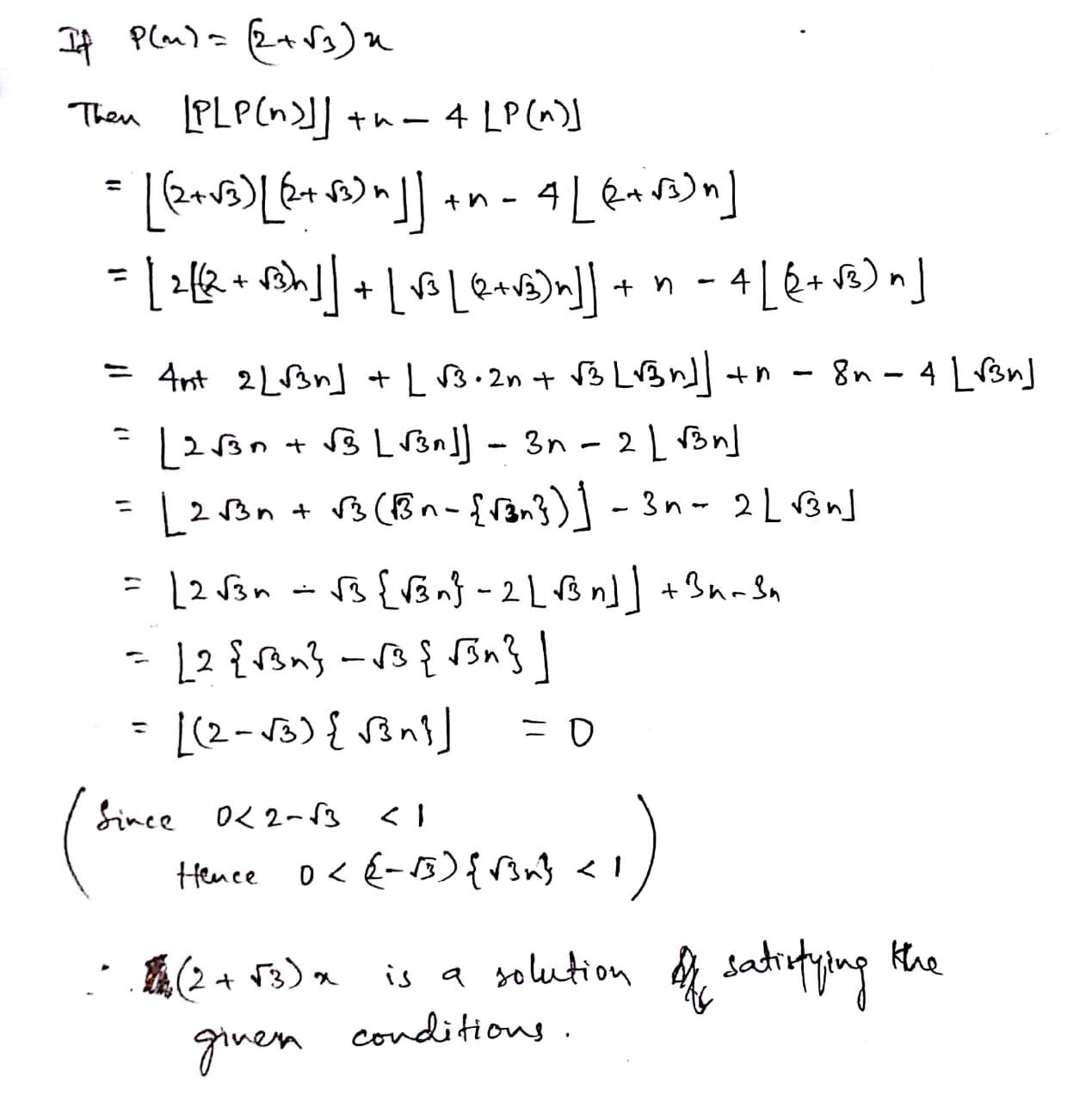New Home › Forums › Math Olympiad - RMO and INMO › POLYNOMIALS
- This topic has 4 replies, 3 voices, and was last updated 6 years ago by
 Nitin Prasad.
Nitin Prasad.
- AuthorPosts
- June 17, 2019 at 10:54 pm #29307
 Prasad sParticipant
Prasad sParticipantFind all polynomials P(x) with real coefficient such that:
P(0) = 0, and ⌊P⌊P(n)⌋⌋ + n = 4⌊P(n)⌋ ∀n ∈ N.June 23, 2019 at 8:30 pm #29360 Agamdeep SinghParticipant
Agamdeep SinghParticipantlet (c,d) be the interval in which [p(n)] = k. (k is some constant in the range of p(x))
let r lie between in the interval (c,d).
we have,
⌊P⌊P(r)⌋⌋ + r = 4⌊P(r)⌋
⌊P(k)⌋ + r = 4k - [eq 1]
let e be such that r+e also lies in (c,d)
⌊P⌊P(r+e)⌋⌋ + r+e = 4⌊P(r+e)⌋
⌊P(k)⌋ + r + e = 4k - [eq 2]
[eq 2] - [eq 1]
e=0
therefore no such interval in which ⌊P(x)⌋ is constant.
since a polynomial is continuous, every polynomial has to take values from some integer m to m + 1 and in the interval [ m , m+1) , ⌊P(x)⌋ = constant. [for p(x) in that range.]
but since there is no such interval in which ⌊P(x)⌋ is constant, there is no such polynomial.
June 25, 2019 at 1:17 am #29387 Nitin PrasadParticipantJune 26, 2019 at 4:42 am #29448
Nitin PrasadParticipantJune 26, 2019 at 4:42 am #29448 Nitin PrasadParticipant
Nitin PrasadParticipantConsider some polynomial P(x) with degree>1. Observe that for large values of natural numbers n, $$\frac{4P(n)}{P(P(n))+n}$$ is approximately 0. Using this idea it seems that our polynomial must be a constant polynomial. Though these were loose arguments and now we need to make our arguments precise. For this, few lemmas have been stated without proof.
Lemma 1 : Consider polynomial P(x) ∈ R[x] of degree n>0 such that its leading coefficient is positive. It can be shown that there exist natural number m such that P(x) is strictly increasing function in the interval [m,\infty).
Lemma 2: Consider polynomial P(x) ∈ R[x] of degree n>1 such that its leading coefficient is positive. Then there exist natural number m such that P(x)>m ∀ x>m and is strictly increasing in the interval [m,\infty)
Proof sketch: Consider polynomial Q(x)=P(x)-x. By lemma 1, there exist m such that Q(x)is strictly increasing in [m,\infty). Hence P(x)-x>0 for all x>m i.e. P(x)>x>m for all x>m.Solution: We consider following cases for P(x) ∈ R[x]-
1) Degree of P(x)>1 & leading coefficient is positive: Then by the above lemma 2, there exist natural number m such that P(x) is strictly increasing function in the interval (m,\infty) and P(x)>m for all x>m . Hence we have-
$$P(P(n)-1))+n-1<P⌊P(n)⌋-1+n <⌊P⌊P(n)⌋⌋ + n = 4⌊P(n)⌋<4(P(n)+1) ∀n ∈ N.$$
$$\Longrightarrow P(P(n)-1))-4P(n)+n-5<0 ∀n ∈ N.$$Now observe that P(P(n)+1))-4P(n)+n+5 is a polynomial of degree>0 with positive leading coefficient. Hence by lemma1 we arrive at a contradiction.
2) Degree of P(x)>1 & leading coefficient is negative: Similar to above case and leads to a contradiction
3) Degree of P(x) at most 1: Consider P(x)=ax+b. Since P(0)=0 Hence b=0. Now we have ⌊a⌊an⌋⌋ + n = 4⌊an ⌋
June 27, 2019 at 10:30 pm #29459 Nitin PrasadParticipant
Nitin PrasadParticipant3) Degree of P(x) at most 1: Consider P(x)=ax+b. Since P(0)=0 Hence b=0. Now we have ⌊a⌊an⌋⌋ + n = 4⌊an ⌋. Now observe that-
$$\lim_{n\longrightarrow\infty}\frac{⌊a⌊an⌋⌋ + n}{4⌊an⌋}=\lim_{n\longrightarrow\infty}$$$$\Longrightarrow \frac{a^2+1}{4a}=1$$
$$\Longrightarrow a=2+\sqrt{3}\; or\; a=2-\sqrt{3}$$
a) $$ P(x)=(2-\sqrt{3})x$$ cannot be a solution for it fails to satisfy the given condition for n=1.
b) Surprisingly $$latex P(x)=(2+\sqrt{3})x$$ does satisfy our solution. The equation
$$⌊(2+\sqrt(3))⌊(2+\sqrt(3))n⌋⌋ + n = 4⌊(2+\sqrt(3))n ⌋$$ reduces to$$⌊(2-\sqrt(3)){\sqrt(3n)} ⌋=0$$ which is indeed true. Calculation part for this shown below

- AuthorPosts
- You must be logged in to reply to this topic.
